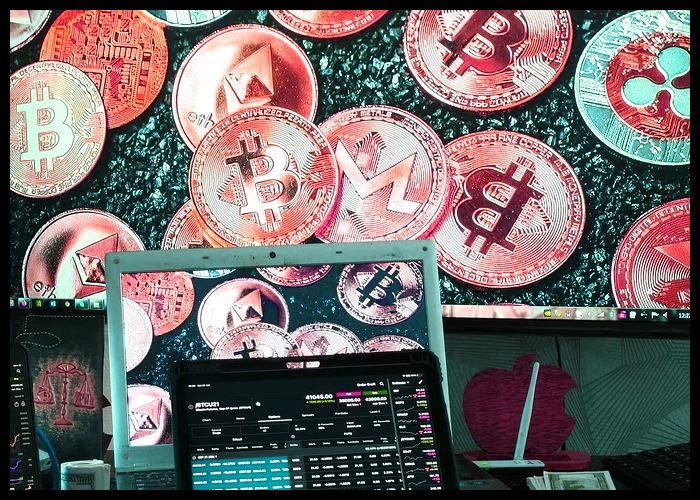

By RTTNews Staff Writer | Published: 2/2/2022 9:36 AM ET

Crypto markets edged down early on Wednesday amidst strong rallies in equities, crude oil futures, gold etc. The decline in the Dollar Index as well as dovish commentary from a few Fed officials that hinted at a lack of convergence on the interest rate trajectory post the March lift-off, did not help cryptocurrencies to tread into positive territory.
Crypto market capitalization is at $1.77 trillion and 24-hour volume clocked $60.98 billion.
Bitcoin is trading at $38,388.66, after losing 1.37 percent in the past 24-hours. Bitcoin's dominance is currently at 41 percent.
Ethereum is currently trading at $2,776.16, after shedding 0.75 percent overnight. Ethereum dominates 18.7 percent of the aggregate crypto market.
Among the top-20 crypto currencies, 12th ranked Avalanche (AVAX) is the best performer with gains of 4.44 percent.
68th ranked Quant's (QNT) gain of 16.32 percent in the past 24 hours is the best in the top-100 category.
Excluding the top-ranked Bitcoin and Ethereum, the mid-cap and small-cap cryptos account for 40.3 percent of the cryptocurrency market.
The U.S. Federal Reserve on Monday released an International Finance Discussion Paper titled "Stablecoins: Growth Potential and Impact on Banking" which examines in detail the basic nature of stablecoins, its use cases and growth potential, the stability of a stablecoin's peg to its reference value, and most importantly the potential impact of stablecoins on credit intermediation.
The paper acknowledges the tremendous growth that stablecoins have seen in the past year, serving as a possible breakthrough innovation in the future of payments and at the same time enumerates a host of issues that have arisen resultantly viz the stability of stablecoins' pegs, consumer protection, know-your-customer and anti-money laundering compliance, as well as the scalability and efficiency of settlements.
Based on research findings, the authors conclude that the broad adoption of asset-backed stablecoins could potentially be supported within a two-tiered, fractional reserve banking system without a negative impact on credit intermediation. In such a framework, stablecoin reserves would be held as commercial bank deposits, and commercial banks would engage in fractional reserve lending and maturity transformation as they normally would with traditional bank deposits.
Alternatively, in a narrow banking framework, in which stablecoin issuers would be required to back their stablecoins with central bank reserves, the risk of "runs" on stablecoins would be minimized, but could potentially reduce credit intermediation.
The document notes that the dollar-pegged stablecoins have exhibited safe asset qualities in that their prices in the secondary market temporarily rose above the peg during times of extreme market distress, incentivizing the issuance of more stablecoins.
Nevertheless, they have highlighted the risk of a "run" on certain stablecoins that are backed by non-cash-equivalent risky assets. The report goes further to state that dollar-pegged stablecoins backed by adequately safe and liquid collateral could, potentially serve as a digital safe haven currency during periods of crypto market distress.
Currently, stablecoins aggregate to $174 billion, dominating 9.76 percent of the cryptocurrency market. The top 5 stablecoins viz Tether (USDT), USD Coin (USDC), Binance USD (BUSD), Terra USD (UST) and Dai (DAI) together command 95 percent of the stablecoin market cap warranting a deeper scrutiny of their recent performance.
January was a turbulent month for cryptos and the not-so-volatile stablecoin segment witnessed a surge in dominance in tandem with the risk aversion in the broader crypto market.
Market leader Tether (USDT) however witnessed a 0.24 percent dip in market capitalization during the month of January and closed at $78.16 billion. 2nd ranked USD Coin (USDC) surged by 18.2 percent to $49.85 billion, from $42.17 billion at the end of December. Third ranked Binance USD (BUSD) gained 4.64 percent to swell to $15.32 billion by January 31, from $14.64 billion, a month earlier. Terra USD(UST) recorded a 10.95 percent jump to $11.25 billion, from $10.14 billion at the end of December. Dai's 3.67 percent uptick saw its market capitalization increase to $9.6 billion, from $9.3 billion earlier.
As the use cases of digital currencies get amplified in public discourse, it is bound to lead to a wider acceptance and adoption in the financial mainstream. Stablecoins, which interface between the world of digital currencies and the fiat currencies have an important role to play in the responsible proliferation of cryptocurrencies. It would do well to build necessary safeguards for stablecoins before cryptos scale up to its full potential.
For comments and feedback contact: editorial@rttnews.com
Article written by an RTT News Staff Writer, and posted on the RTT News.com website.
Article reposted on Markethive by Jeffrey Sloe
